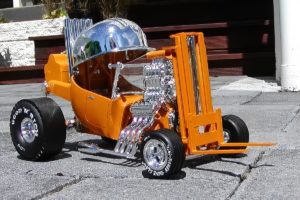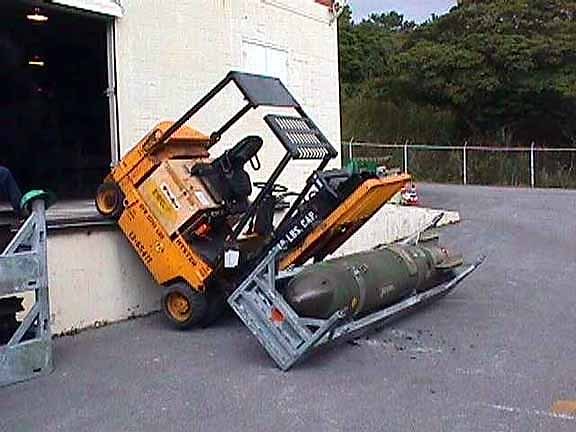From a young age, many children are typically drawn to things that are fast. Fast toys, fast race cars, sports that require speed. Is it possible that “feeding” this desire tends to make many of us resist, whether consciously or subconsciously, the request or demand to “Slow down!” once we’ve grown up, even when we know that it is the right and wise thing to do? Now couple this with the natural tendency of most businesses to push for more productivity by doing things faster and more efficiently. This can be dangerous when we take this combination into a workplace where forklifts are a necessary and integral part of the day-to-day operations.
Race cars are designed to go fast, and they rely on a properly trained and experienced driver to complete a race successfully and safely. Forklifts are designed to lift and transport heavy loads, and they also rely on a properly trained and experienced driver to successfully and safely complete the tasks they are designed for. The statistics for injuries from the use of forklifts and industrial trucks may surprise you. A recent estimate by the Bureau of Labor Statistics (BLS) estimates that approximately 8,500 to 9,000 non-fatal forklift accidents occurred each year between 2011 and 2017 in the US. In 2019 alone, the National Safety Council (NSC) attributed 79 deaths to the use of forklifts in the workplace. These injuries are not just those that happen to forklift operators…a large number of them happen to pedestrians and other co-workers who are struck by the forklift or by a falling load.
Excessive speed is consistently given as one of the top 4 causes of all these injuries and deaths. When forklifts go too fast for conditions, bad things can and do happen. How fast is “too fast” for a forklift? This is something that must be determined by each individual facility where a forklift is being used. Some of the important factors that must be considered when determining a safe speed for a forklift are:
- Size and weight of the forklift and load being carried
- Type of forklift (i.e. stand-up, sit down, reach truck, etc.)
- Type and condition of surfaces being driven on (i.e. concrete, asphalt, smooth or rough, wet)
- Number and proximity of pedestrian traffic
- Amount of other forklift traffic
- Warehouse and factory aisle widths
- Visibility around fixed obstacles and turns
- Inclines and declines to navigate
ANSI/ITSDF B56.1 defines “the safety requirements relating to the elements of design, operation, and maintenance of low lift and high lift powered industrial trucks controlled by a riding or walking operator, and intended for use on compacted, improved surfaces”. This standard provides methods for testing the service brakes and for estimating the stopping distance required for each forklift, both of which are impacted by the maximum speed setting of the forklift being tested. Using this standard along with the expertise and experience of forklift dealers and manufacturers, businesses can help ensure their workplace is safe with respect to forklift speed. New forklifts leave the factory at a preset maximum speed which does vary from manufacturer to manufacturer. Once a safe maximum speed has been determined for a facility, that value must then be set on each forklift. Not all forklifts have a speed control feature, so the dealer or manufacturer must make that change for them. Although it is not an enforced standard, 5 mph is the “safe maximum speed limit” that is generally accepted by the forklift industry. OSHA has not defined a standard setting for forklift speed…the maximum safe speed is left up to each employer to determine. On average, most companies choose to decrease their maximum speed setting to 5 mph, especially when there are pedestrians and other forklifts present in the work area. It is possible that this maximum speed setting may need to be reduced even further based on the unique features of each workplace environment. MHEDA (Material Handling Equipment Distributors Association) recommends a 3 mph maximum speed in areas with high pedestrian traffic.
Possibly more important than determining a maximum speed setting for forklifts in a facility is the implementation of proper training for each forklift operator. It is mandatory that every forklift operator is trained and certified to operate a forklift and that the performance of each operator is evaluated every 3 years based on the provisions found in OSHA standard CFR 1910.178.l.3. In addition to these training requirements, there are additional guidelines that address forklift speed found in 1910.178.n.1, n.4, n.8, n.10, n.11, n.12, and n.15. Employers should be familiar with these guidelines and make sure that their forklift operators understand and follow them. Operators must be made aware of all the risks and hazards associated with excessive speed such as compromised steering, the risk of tip-over, and an increase in stopping distance. It is estimated that approximately 70% of forklift accidents in the workplace can be prevented with the use of stringent training policies and the enforcement of forklift safety rules. Determining and enforcing safe maximum speeds for forklifts is also an excellent business practice that can help prevent many severe injuries and even deaths that occur each year.
If you need an investigation of an incident or injury involving any type of forklift or industrial powered vehicle, please call our experienced mechanical engineering experts at Warren.
Bob Hickman is a Licensed Professional Engineer and Certified Machinery Safety Expert. He has over 30 years of manufacturing and machine design experience in production and quality-driven environments. Bob holds a Bachelor of Science in Mechanical Engineering from Clemson University. Over his 30-year engineering career, Bob has designed many custom manufacturing machines and processes that improved quality, productivity, reliability, and safety. He designed several machines to automate manual processes, replacing inefficient/unreliable manual equipment and has assisted with plant layout/production line planning. He has significant experience with pneumatic systems and components, as well as hydraulics. Bob regularly investigates personal injury, wrongful death, and product liability claims, as well as property damage claims involving machinery and equipment in a variety of environments for both insurance adjusters and attorneys. Bob has an in-depth knowledge of many standards with emphasis on ANSI B11 standards for machine tool safety.





